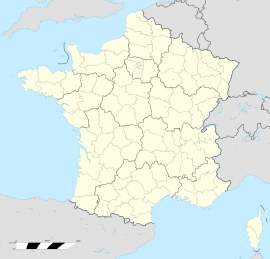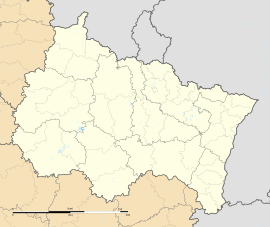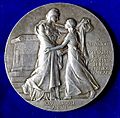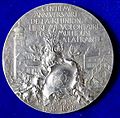Mulhouse facts for kids
Quick facts for kids
Mulhouse
Mìlhüsa (Alemannic German)
|
|||
|---|---|---|---|
|
Subprefecture and commune
|
|||
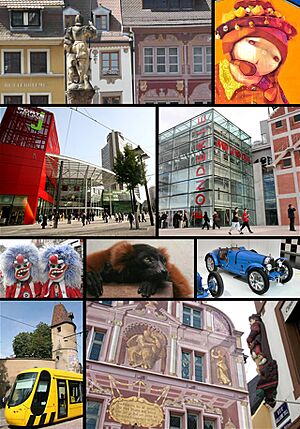 |
|||
|
|||
| Country | France | ||
| Region | Grand Est | ||
| Department | Haut-Rhin | ||
| Arrondissement | Mulhouse | ||
| Canton | Mulhouse-1, 2 and 3 | ||
| Intercommunality | Mulhouse Alsace Agglomération | ||
| Area
1
|
22.18 km2 (8.56 sq mi) | ||
| • Urban | 239.1 km2 (92.3 sq mi) | ||
| Population
(2021)
|
106,341 | ||
| • Density | 4,794.5/km2 (12,417.6/sq mi) | ||
| • Urban
(2017 2021)
|
246,692 Metro 6,394,037 Oberrhein | ||
| Time zone | UTC+01:00 (CET) | ||
| • Summer (DST) | UTC+02:00 (CEST) | ||
| INSEE/Postal code |
68224 /68100, 68200
|
||
| Dialling codes | 0389, 0369 | ||
| Elevation | 232–338 m (761–1,109 ft) (avg. 240 m or 790 ft) |
||
| 1 French Land Register data, which excludes lakes, ponds, glaciers > 1 km2 (0.386 sq mi or 247 acres) and river estuaries. | |||
Mulhouse is a city in France, located in the European Collectivity of Alsace. It's close to the borders of Switzerland and Germany. Mulhouse is the second largest city in Alsace, right after Strasbourg. Its name means "mill house."
This city is famous for its amazing museums. You can find the Cité de l'Automobile, which is the biggest car museum in the world. There's also the Cité du Train, the world's largest railway museum. Mulhouse was once called "the French Manchester" because it was a big industrial town. It's also home to the Upper Alsace University.
Contents
- Understanding Mulhouse's Government
- A Look at Mulhouse's History
- Mulhouse's Location and Landscape
- Mulhouse's Population Growth
- Top Places to Visit in Mulhouse
- Mulhouse's Economy and Industries
- Learning in Mulhouse
- Getting Around Mulhouse
- Sports in Mulhouse
- Famous People from Mulhouse
- Mulhouse's Sister Cities
- Images for kids
- See also
Understanding Mulhouse's Government
Mulhouse is a commune, which is like a local government area in France. In 2019, about 108,312 people lived here. The city is also part of a larger "urban unit" called Mulhouse, which had over 247,000 people in 2018.
Mulhouse is the main city for 39 other communes that form the Mulhouse Alsace Agglomération (m2A). This group works together on things like public transport and economic development. Mulhouse is also a subprefecture, meaning it's an important administrative center in France.
A Look at Mulhouse's History
Mulhouse has a long and interesting past. The first records of the town are from the 1100s. For a long time, it was part of the Holy Roman Empire, a large group of lands in central Europe. From 1354 to 1515, Mulhouse was one of ten "Free Imperial Cities" in Alsace, meaning it was quite independent.
In 1515, Mulhouse joined the Old Swiss Confederacy, a group of independent states that later became Switzerland. This meant that when France took over the rest of the Sundgau region in 1648, Mulhouse remained a free and independent republic. It was a Calvinist republic, which is a type of Protestant Christian community.
However, in 1798, during the French Revolution, the citizens of Mulhouse voted to become part of France. This was made official with the Treaty of Mulhouse.
Industrial Growth and Changes
In the mid-1700s, the Koechlin family started making cotton cloth in Mulhouse. This made the city a major textile center in France during the 1800s. Factories like André Koechlin's, which made machinery and railroad equipment, grew very quickly. By 1839, his company employed 1,800 people. Mulhouse became known as "the French Manchester" because it was so important for industry, just like Manchester in England.
After the Franco-Prussian War in 1871, Mulhouse became part of the German Empire. It was briefly occupied by French troops at the start of World War I in 1914, but they had to leave. After the war ended in 1918, Mulhouse returned to France under the Treaty of Versailles. It was occupied by German forces again during World War II in 1940, but finally returned to French control in May 1945.
Mulhouse's growth was driven by industries like textiles, leather tanning, chemicals, and engineering. This industrial past is why the city center is relatively small compared to its industrial areas.
Mulhouse's Location and Landscape
Mulhouse is located where two rivers, the Doller and the Ill, flow into the larger Rhine river. It's about 100 kilometers (62 miles) from Strasbourg and Zürich. The city is also very close to Basel, Switzerland and Freiburg, Germany. These three cities even share an international airport, the EuroAirport Basel-Mulhouse-Freiburg.
Exploring Mulhouse's Districts
Mulhouse has different parts, each with its own history:
- The lower town was the old inner city where merchants and craftspeople lived. It grew around the Place de la Réunion, a square that celebrates Mulhouse rejoining France. Today, this area is for pedestrians only.
- The upper town started to develop in the 1700s. Before that, it was home to several religious groups like the Franciscans and Knights of Malta.
- The Nouveau Quartier (New District) is a great example of city planning from the 1800s. It was built after the old city walls were taken down. This area, with its unique triangular shape, was designed by architects G. Stolz and Félix Fries. Rich families and factory owners lived here.
- The Rebberg district features large houses that look like the homes of cotton planters in Louisiana, USA. The name "Rebberg" comes from "Rebe," meaning "vine" in German, as it was once a vineyard. Many houses here are built in the English terraced style, showing the city's strong connection to Manchester through its industrial past.
Mulhouse's Climate
Mulhouse has a temperate climate, meaning it has four distinct seasons. Because it's further from the ocean, winters can be colder with some snow. Summers are often hot and humid.
Mulhouse's Population Growth
The population of Mulhouse has changed a lot over the years. The city grew significantly during the industrial boom. In 1914, the area of Dornach became part of Mulhouse, and in 1947, Bourtzwiller joined as well.
| Historical population | |||||||||||||||||||||||||||||||||||||||||||||||||||||||||||||||||||||||||||||||||||||||||||||||||||||||||||||||||||
|---|---|---|---|---|---|---|---|---|---|---|---|---|---|---|---|---|---|---|---|---|---|---|---|---|---|---|---|---|---|---|---|---|---|---|---|---|---|---|---|---|---|---|---|---|---|---|---|---|---|---|---|---|---|---|---|---|---|---|---|---|---|---|---|---|---|---|---|---|---|---|---|---|---|---|---|---|---|---|---|---|---|---|---|---|---|---|---|---|---|---|---|---|---|---|---|---|---|---|---|---|---|---|---|---|---|---|---|---|---|---|---|---|---|---|---|
|
|
||||||||||||||||||||||||||||||||||||||||||||||||||||||||||||||||||||||||||||||||||||||||||||||||||||||||||||||||||
| Source: EHESS and INSEE (1968–2017) | |||||||||||||||||||||||||||||||||||||||||||||||||||||||||||||||||||||||||||||||||||||||||||||||||||||||||||||||||||
Top Places to Visit in Mulhouse
Mulhouse has many interesting sights, especially its famous museums.
- Hôtel de Ville (Town Hall): Built in 1553, this beautiful building is known for its "trompe-l'œil" paintings. These paintings create an optical illusion, making flat surfaces look three-dimensional.
- Workers' Quarter: This area, built in the mid-1800s, was designed for factory workers. It inspired similar neighborhoods in other industrial cities.
- Place de la Bourse and the Société Industrielle de Mulhouse building: These are important landmarks in the New District, showing the city's industrial past.
- Cité de l'Automobile: Home to the amazing Schlumpf collection of cars, it's the largest automobile museum in the world.
- Cité du Train: This is the French National Railway Museum, a must-see for train lovers.
- Museum of Electricity (Electropolis): Learn all about electricity and its history.
- Fine Arts Museum: Explore a collection of beautiful artworks.
- History Museum: Located in the Town Hall, this museum tells the story of Mulhouse.
- Museum of Printed Textiles: Discover the history and art of textile printing, a key industry for Mulhouse.
- Mulhouse Zoo and Botanical Garden: Enjoy a day with animals and beautiful plants.
- Saint-Steffen Calvinist temple: A significant religious building built in the mid-1800s.
- Street Art: Keep an eye out for cool street art around the city, including a picture of Milhouse Van Houten from The Simpsons!
Mulhouse's Economy and Industries
Mulhouse has long been a center for industry. It was known as "the industrial capital of Alsace" and "the city with a hundred chimneys."
Today, its main industries include:
- Automobile industry: The Peugeot factory is the biggest employer in Alsace.
- Chemical industry (ICMD)
- Electronics (Clemessy)
- Engineering (SACM – Wärtsilä)
Learning in Mulhouse
The École nationale supérieure de chimie de Mulhouse, the first chemistry school in France, is located in the city. This shows Mulhouse's strong connection to science and industry.
Getting Around Mulhouse
Mulhouse has many ways to travel, making it easy to explore.
Air Travel
Mulhouse shares the EuroAirport Basel-Mulhouse-Freiburg with Basel and Freiburg. It's about 25 kilometers (15 miles) south of the city.
Train Travel
The Gare de Mulhouse (Mulhouse train station) connects the city to many places in France, including Paris, Lyon, and Strasbourg. You can also take trains to Switzerland (Basel, Bern, Zürich) and Germany (Frankfurt). Regional trains connect Mulhouse to nearby towns and cities.
City Transport
Within Mulhouse, you can use Soléa's network of buses and trams. The city's tram system opened in 2006 and has three tram lines and one tram-train line. The tram-train even goes to Thann!
Roads
The A36 motorway connects Mulhouse to cities like Dijon, Paris, and Lyon to the west. The A35 motorway runs north-south, linking Mulhouse to Strasbourg and Basel.
Sports in Mulhouse
Mulhouse is a strong center for women's volleyball. The ASPTT Mulhouse team has won many national titles and plays its home games at the Palais des Sports. The city also has a basketball team, FC Mulhouse Basket.
Famous People from Mulhouse
Many notable people were born in Mulhouse, including:
- Alfred Dreyfus (1859–1935), a French military officer famous for the Dreyfus affair.
- David Cage (born 1969), a video game designer who was the first to receive France's highest honor, the Legion of Honour.
- Katia and Maurice Krafft, famous volcanologists who studied volcanoes around the world.
- Johann Heinrich Lambert (1728–1777), a brilliant mathematician, physicist, and astronomer.
- William Wyler (1902–1981), an award-winning motion picture director.
- Alfred Werner (1866–1919), who won the Nobel Prize in Chemistry in 1913.
- Vitaa (born 1983), a popular singer.
Mulhouse's Sister Cities
Mulhouse has "twin" or "sister" city relationships with several cities around the world. These partnerships help promote cultural exchange and understanding.
Images for kids
-
Hôtel de Ville (Rothüs in Alsatian)
See also
 In Spanish: Mulhouse para niños
In Spanish: Mulhouse para niños




